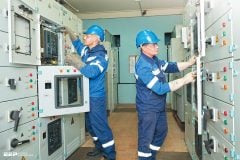 The Siemens’s transformer GEAFOL principle has succeeded in producing transformers with excellent electrical, mechanical and thermal characteristics, which have also proved to be particularly compatible with the environment.
The Siemens’s transformer GEAFOL principle has succeeded in producing transformers with excellent electrical, mechanical and thermal characteristics, which have also proved to be particularly compatible with the environment.
GEAFOL transformers are insulated with an epoxy resin/quartz powder mixture. This is an environmentally acceptable material that makes the windings maintenance-free, moisture-resistant, tropicalized, flame-retardant and self-extinguishing.
Even when the insulation is exposed to arcing, no toxic gases are generated. The windings are clamped between resilient spacers that provide effective vibration insulation both from the iron core and mutually between windings.
The result: GEAFOL transformers are as quiet as oil immersed types.
Electrically safe: The aluminum foil winding
The coils of the high-voltage windings are made of aluminum foil. Why foil windings? Because foil windings combine a simple winding technique with a high degree of electrical safety. The insulation is subjected to less electrical stress than in other types of windings.
In a conventional round-wire winding, the interturn voltages can add up to twice the interlayer voltage, while in a foil winding it never exceeds the plain voltage per turn because each layer consists of only one winding turn. The result: High power frequency and impulse voltage withstand capability.
Why aluminum? The thermal expansion coeffi cients of aluminum and the used cast resin are so similar that thermal stresses due to load changes are kept to a minimum.
No gas inclusions: The epoxy resin casting process
 The high voltage windings are potted with epoxy resin under vacuum at a high temperature. This procedure prevents undesirable gas inclusions. The quality of the potting combined with the electrical advantages of the foil winding plays a decisive role in providing freedom from partial discharges (up to twice the rated voltage).
The high voltage windings are potted with epoxy resin under vacuum at a high temperature. This procedure prevents undesirable gas inclusions. The quality of the potting combined with the electrical advantages of the foil winding plays a decisive role in providing freedom from partial discharges (up to twice the rated voltage).
The low-voltage strip winding is also of aluminum. The width of the aluminum strip is equal to the length of the coil. This considerably reduces axial short-circuit forces in the transformer. The conductor strip and the insulation material are bonded together by heating and thus form a compact unit with suffi cient strength to withstand radial forces reliably.
Universal: The application areas
Dry-type transformers must be marked with proven environmental, climate and fi re resistance ratings.
Siemens’s GEAFOL cast-resin transformers are suitable for universal use and satisfy the requirements of the highest defi ned classes, as proven in comprehensive testing:
- Environmental class E2
- Climate category C2*
- Fire resistance class F1
* For outdoor installation, IP 23 degree of protection must be maintained.
50 % performance reserves with radial-flow fans
Radial-flow fans with temperature-dependent control can be installed to provide capacity reserves and to cover peak load periods. In this way, the transformer output can be raised by up to 50%. To simplify installation and connection, the transformer is optionally available with connection on either the HV or LV side, top or bottom. Plug connections are also available.
Since the GEAFOL transformers often need less space than liquid-filled and gas-insulated transformers, a higher output can be accommodated in the same area. The modular design of the transformer is another economical feature. Windings, for instance, can be mounted and replaced on the spot.
Economical
No maintenance, no maintenance costs GEAFOL transformers are practically maintenance-free. Once connected, in most cases they can be left to get on with their job.
If the advantages of GEAFOL transformers are taken into consideration as early as at the planning stage, the overall costs of a power supply system can often be considerably reduced.










